My Findings from the Battelle Darby Field Trip!
Battelle Darby Metro Park is located roughly 30 minutes southwest of Columbus. Since this is considered more Western Ohio, the soil tends to be composed of limestone—making for poorly drained and poorly aerated soil. Since this is land that a glacier once covered, the nutrients are abundant. First, I’ll cover four plants found at Battelle Darby that are limestone-loving plants (Calciphiles!).
Below is the first calciphile—an American Hackberry (Celtis occidentalis). As I stated on my Trees page, the American Hackberry have leaves that are alternate in arrangement, simple in complexity, serrate, and uneven at the base. The pith is generally chambered. Hackberries also produce 1-seeded fruit that are eaten by many birds including chickens, pheasants, and wild turkey.

Another calciphile is a Blue Ash (Fraxinus quadrangulata). Blue Ash leaves are opposite in arrangement, pinnately compound, and entire. The twigs are square in cross-section (notice the second picture!). A fun fact about the Blue Ash is that its inner bark produces a blue dye.
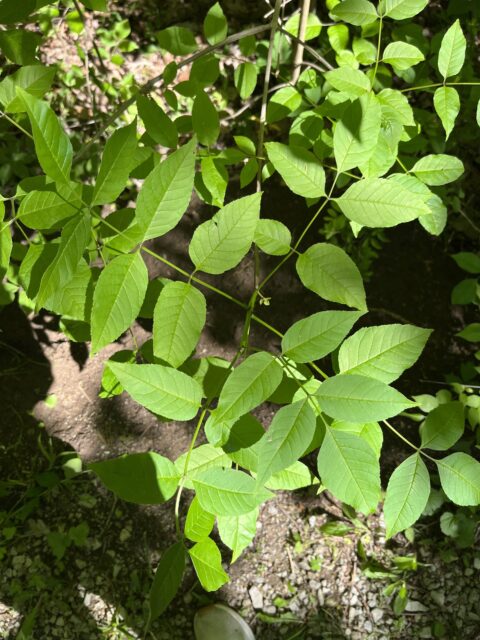

Below is the third calciphile—a Chinquapin Oak (Quercus muehlenbergii). Chinquapin Oaks have leaves that are alternate in arrangement, simple in complexity, and bluntly lobed. Their twigs, buds, and acorn cups look similar to Chestnut Oak, but Chinquapin has light gray and flaky bark.

The fourth calciphile is Fragrant Sumac (Rhus aromatica). Fragrant Sumac has leaves that are alternate in arrangement and trifoliate in complexity. A notable feature of Fragrant Sumac is that its leaves are aromatic! It also produces fruits that are drupes (and edible!).
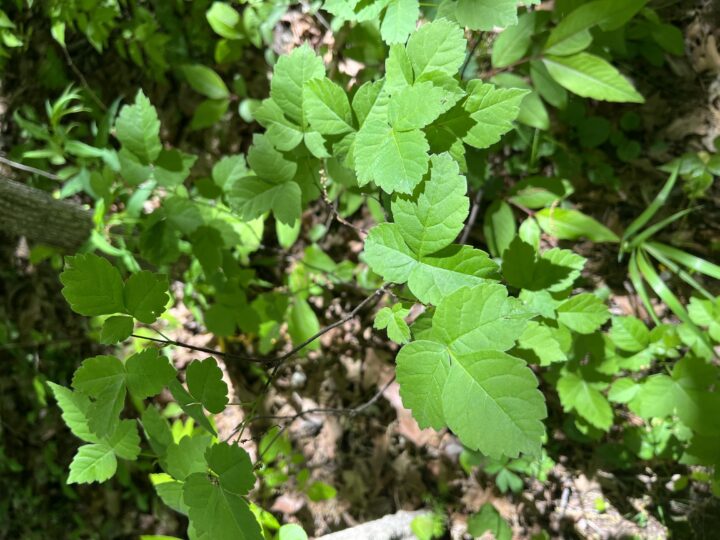
We also identified two invasive species at Battelle Darby! The first is Amur Honeysuckle (Lonicera maackii) pictured below. Its leaves are alternate in arrangement and simple in complexity. Amur Honeysuckle tends to spread aggressively, and since it leafs before other plants, it tends to provide too much shade for native plants. Its berries also do not provide much nutritional value to wildlife.
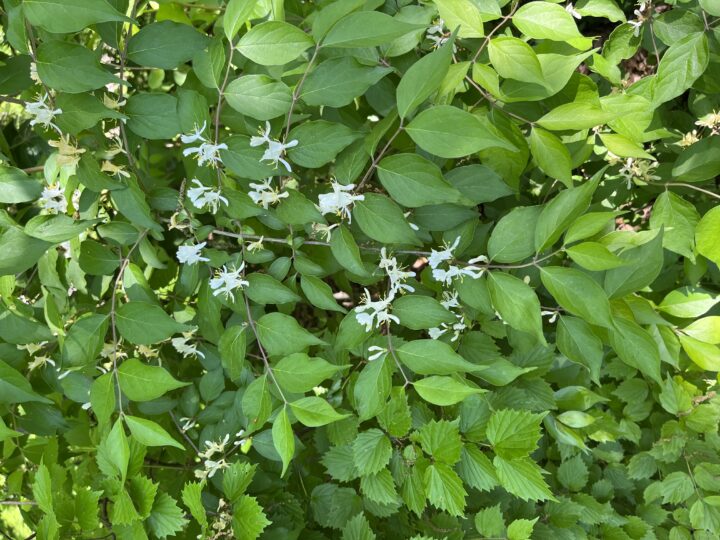
Another invasive species we identified was Garlic Mustard (Alliaria petiolata). During its first year of growth, Garlic Mustard grows in rosettes. During its second year of growth, Garlic Mustard has leaves alternate in arrangement. Its fruit are siliques (see the second photo) with a single row of seeds contained in the capsule. After growing seeds in the second year, it dies.
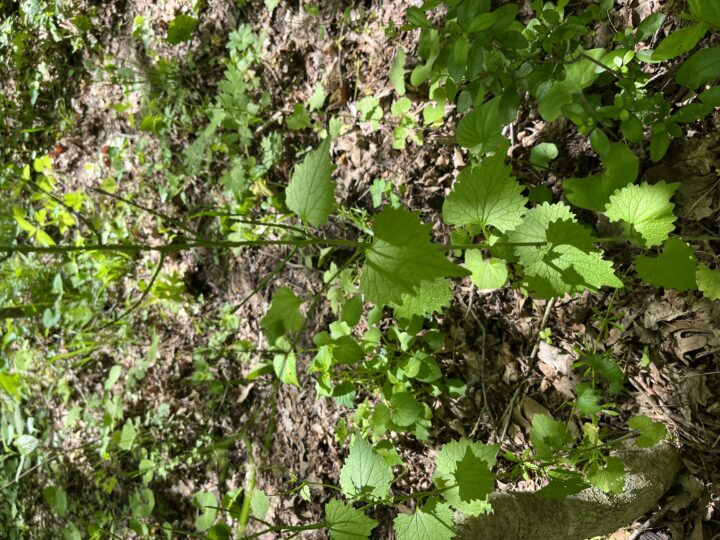

My personal assignment was to find two members of families that we’ve already learned in class. The first plant I identified was a Golden Alexander (Zizia aruea) in the family Apiaceae. Golden Alexanders grow in meadows, shores, and open woods. The leaves are two- to three- times divided with sharp teeth.
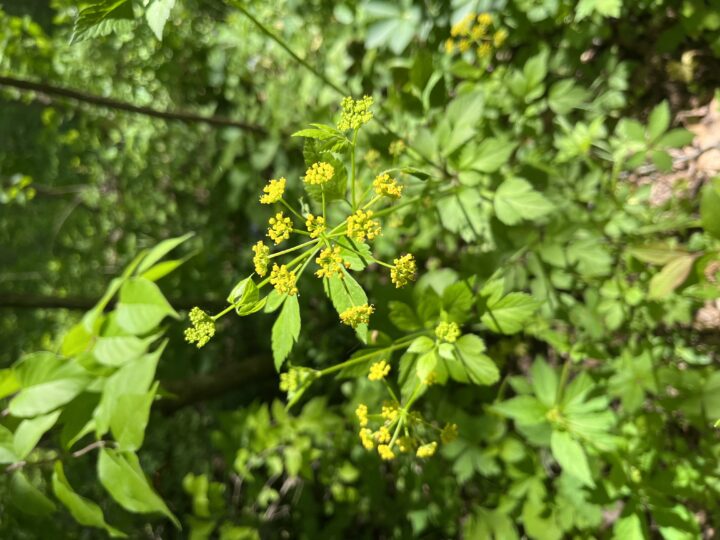
The second plant I identified was an Ohio Buckeye Tree (Aesculus glabra)! Ohio Buckeyes have leaves that are opposite in arrangement and palmately compounded. When the twigs are broken, it emits a foul, skunk-like odor. The fruit is, of course, a buckeye (nut)!
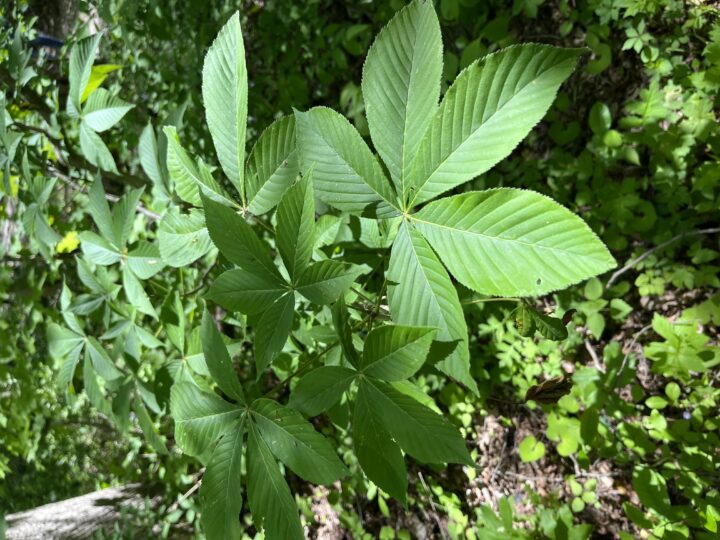
After reading Jane Forsyth’s Article on Geobotany, here are my answers to the questions asked on the Carmen page!
- The geology of Ohio can be divided into two parts—eastern and western Ohio. Eastern Ohio was once covered in a glacier, so the till is composed of limestone. Western Ohio is composed of limestone.
- The original sequence of sedimentary rock strata was a series of limestone layers, covered by shales, then covered by sandstone. These layers were tilted into a low arch before erosion. Erosion cut deepest in the crest of the arch which was where the oldest rocks (limestone) were, which is north-south through western Ohio. The youngest rocks (sandstone) were at the lowest part of the arch. Erosion cut into the sandstone without eroding it completely, which made for sandstone hills characteristic of eastern Ohio. The important river system that occupied Ohio for a long time was the Teays River. It flowed for around 200 million years, eroding the land during that time. Glaciers of the Ice Age eventually curtailed the river’s activities.
- The Pleistocene glaciers were slowed by the steep sandstone hills of eastern Ohio, which creates a distinct glacial boundary.
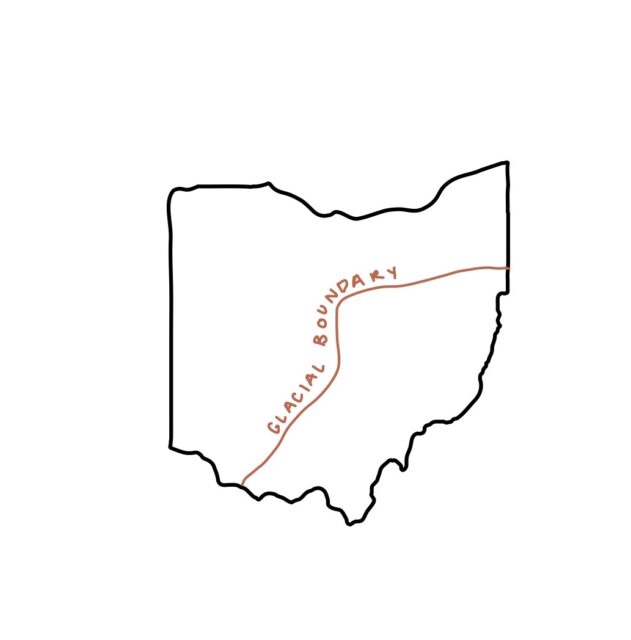
- Glacial till is glacier deposition composed of sand, silt, clay, and boulders. Glacial till differed in eastern and western Ohio. In eastern Ohio, the till is comprised little of lime and clay, until it reaches the sandstone hills. In western Ohio, the till is comprised mostly of lime and clay as the glacier cut into the limestone bedrock.
- The basic substrate for plants in western Ohio is lime/clay till. This makes the soil impermeable, poorly draining, and poorly aerated. The basic substrate for plants in eastern Ohio is sandstone bedrock. This is very permeable, very acidic, and low in nutrients.
- Five species of trees & shrubs limited to limestone are redbud, red-cedar, fragrant sumac, hackberry, and blue ash.
- Five species of trees & shrubs limited to high-lime, clay-rich substrates in western Ohio are sugar maple, beech, red oak, shagbark hickory, and white oak.
- Five species of trees & shrubs limited to the sandstone hills of eastern Ohio are chestnut oak, sourwood, scrub pine, pitch pine, and hemlock.
- The major determinate of the distribution of sweet buckeye is whether it is glaciated land. Sweet buckeye is unable to repopulate in the clay and high-lime glacial till. Hemlock, on the other hand, has a more extensive distribution because it can only repopulate in cool, moist environments like valley-bottom sites found in glaciated Ohio. Rhododendron appears only in unglaciated Ohio, but only in certain locations. This can be explained because Rhododendron originally migrated down via the Teays River. Now, the species remains near the main valleys of the old Teays River.
